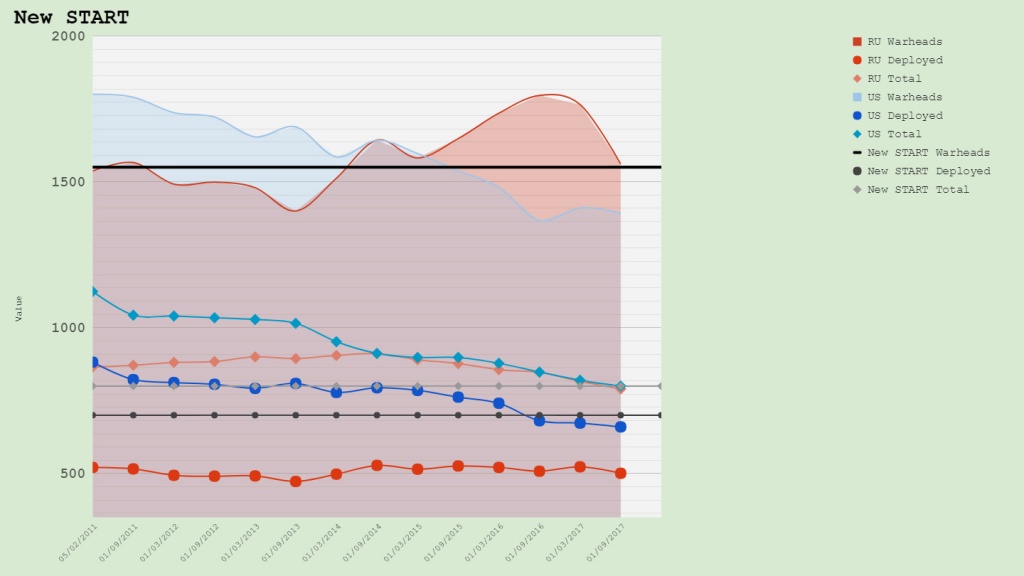The number of nuclear warheads deployed by the Russian Federation on strategic launchers was cut by more than two hundred units between March and September 2017. According to the official data released by the US Department of State, 1,561 warheads are deployed on 501 missiles, while the total number of deployed and non-deployed launchers of intercontinental ballistic missiles (ICBMs), submarine-launched ballistic missiles (SLBMs) and heavy bombers (HB) is 790. For the United States, the figures are 1,393, 660 and 800 respectively.
Thus, a few months before February 2018, the parties approached the agreed limits of strategic nuclear arsenals, that is, 1,550 deployed warheads, 700 deployed and 800 deployed and non-deployed launchers.
Reaching the ceiling: on the way to fulfilling the reductions under the New START
The number of nuclear warheads deployed by the Russian Federation on strategic launchers was cut by more than two hundred units between March and September 2017. According to the official data released by the US Department of State, 1,561 warheads are deployed on 501 missiles, while the total number of deployed and non-deployed launchers of intercontinental ballistic missiles (ICBMs), submarine-launched ballistic missiles (SLBMs) and heavy bombers (HB) is 790. For the United States, the figures are 1,393, 660 and 800 respectively.
Thus, a few months before February 2018, the parties approached the agreed limits of strategic nuclear arsenals, that is, 1,550 deployed warheads, 700 deployed and 800 deployed and non-deployed launchers.

There were some opinions that it would be difficult for Russia to reach target values, however, the September data obviously indicate that this task is being fulfilled. As usual, questions remain on the direct path to such figures. Presumably, the reduction could have been achieved in two main ways:
1) The withdrawal of one or several venerable type 667BDR submarines of the Pacific Fleet, capable of carrying 16 R-29RKU-02 (SS-N-18) SLBMs, 3 warheads per missile, from active duty. According to the info posted on Makeyev design bureau website, the life-extension term of these submarines ends precisely in 2017.
2) The decommissioning of legacy “Heavy” ICBMs, carrying up to 10 warheads in case of famous SS-18 “Satan” or 6 for SS-19 “Stiletto”, whose service after repeated life extension programs also obviously approaches its end.
A grand ceremony for any of these events could have become a vivid symbol of Russia's peaceful foreign policy and a commitment to nuclear disarmament, but the obvious problems with the development of the new heavy SS-30 “Sarmat” ICBM and the negative trail in the SS-N-32 “Bulava” SLBM program may have led to a negative reaction within Russia.
For American partners everything is a bit simpler: the reduction of the deployed Minuteman III ICBMs to 400 units (50 missiles retired from operational duty) have been completed, and their modernization has also been carried out. Also, the "denuclearization" of an overwhelming number of B-52H bombers has been finished, and the number of SLBM launchers in submarines of Ohio class is being reduced. A few months from now, the traditional publication of more detailed information is expected.
Unfortunately, a rather strange situation remains: the expert community is forced to use data on a bilateral treaty submitted exclusively by the US side, and that’s given the emphasis on parity in the Russian foreign policy. So we can’t expect any details on Russian strategic nuclear forces.
The treaty is working successfully and remains one of the strategic stability cornerstones, even under constant pressure from "hawks", and "doves" from both sides, that complain about the possibility of rapidly increasing the number of warheads, about the number of warheads on Russian land-based ICBMs or about the general principle of counting heavy bombers without regard to their ability to carry a significant number of nuclear bombs and cruise missiles.
At the same time, the prospect of New START being extended beyond 2021 remains questionable, which seems to be one of the key threats in the medium-term, especially considering the ongoing program of modernization of the nuclear arsenal in Russia and the beginning of such in the US.





